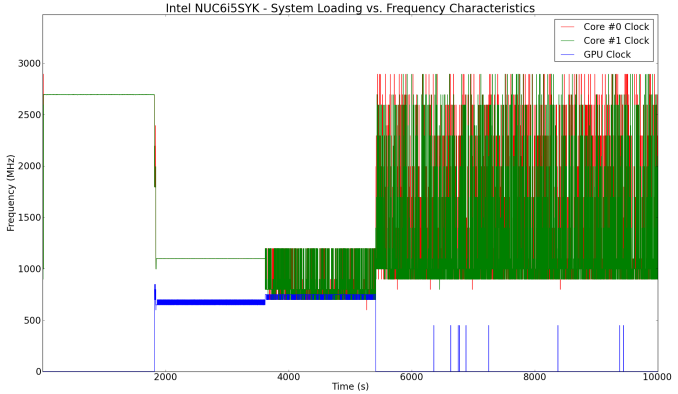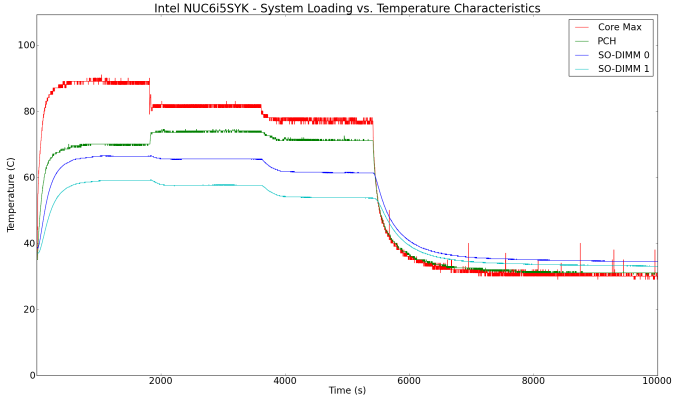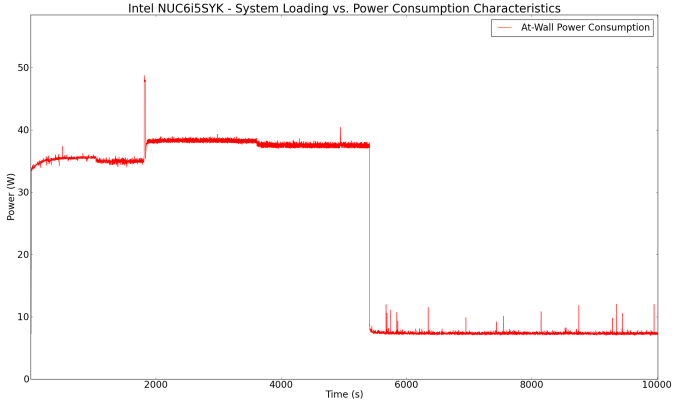The Intel NUC6i5SYK Skylake UCFF PC Review
by Ganesh T S on March 11, 2016 8:00 AM ESTPower Consumption and Thermal Performance
The power consumption of the NUC6i5SYK at the wall was measured with a 1080p display being driven through the HDMI port. In the graphs below, we compare the idle and load power of the Intel NUC6i5SYK with other low power PCs evaluated before. For load power consumption, we ran Furmark 1.12.0 and Prime95 v27.9 together. While the idle power number is consistent with a system sporting a 15W TDP processor, the load power is quite high at 38.37W (considering that the Haswell-based NUCs idled a full 10W lower while also using a 15W TDP processor).


Analyzing the AIDA64 system report and the default BIOS configuration revealed that the unit was optimized for maximum performance. The long duration CPU power limit was set to 23W for a time duration window of 96s and the short duration CPU power limit was set to 30W for 2.44ms. For comparison, the Core i7-6600U in the Surface Book has a long duration CPU limit of 15W for 28s and a short duration limit of 25W for 2.44ms. As we shall see further down in this section, the Core i5-6260U in the NUC6i5SYK doesn't pull back significantly from the 23W limit even under sustained load (despite the 96s configuration).
Moving on to our thermal stress routine, we started with the system at idle, followed by 30 minutes of pure CPU loading. This was followed by another 30 minutes of both CPU and GPU being loaded simultaneously. After this, the CPU load was removed, and the GPU was loaded alone for another 30 minutes. The various clocks in the system as well as the temperatures within the unit are presented below.
We find that the cores spend very little time at the turbo speed of 2.9 GHz, but the steady clock rate is around 2.6 GHz throughout the duration when the CPU was completely loaded. The Core i5-6260U is advertised with a base clock of only 1.8 GHz. There is no throttling at play here even under full CPU load. However, when the GPU gets loaded , the cores drop down to around 1.1 GHz even under load. As we shall see further down, this is probably limited by package power. The GPU cores have a base frequency of 300 MHz (turbo to 950 MHz). Under load, we see it operate between 600 - 700 MHz depending on whether the CPU is loaded simultaneously or not.
According to the official specifications, the junction temperature of the Core i5-6260U is 100C. The thermal solution is more than good enough to maintain the temperature below 90C even under extreme stress. The cores also idle around 33C.
In addition to the frequencies and temperature, we also tracked the power consumption at the wall during the thermal stress testing process. Here, we find that the performance of the system is actually limited by the maximum sustained power consumption limit (around 38W under the tested load conditions) for the system. Irrespective of the CPU and GPU loading, the power consumption is kept under these limits (except for the short spike close to 48W corresponding to the Short Duration Power Limit reported by CPUID).
Since the NUC6i5SYK is not a passively cooled PC, we decided to skip our usual thermal photographs. Given the observed internal temperatures during thermal stress testing and the thermal design (case with adequate number of vents, a blower solution and a plastic lid), we believe that the external case temperatures will not be a cause for concern even under heavy system load.













95 Comments
View All Comments
CajunArson - Friday, March 11, 2016 - link
Keep in mind that the older i7 NUC is a 28 watt TDP part with a 3.1GHz *base* clock (turbo to 3.4GHz) while this is a 15 watt part with only a 2.9GHz *turbo* maximum clock. It seems to beat the older i5 Broadwell at CPU benchmarks too.MattMe - Friday, March 11, 2016 - link
I've been buying NUCs for desktop replacements at work now for the last year. We have around 40 Broadwell units and so far around 20 Skylake units.I've never experienced any of the issues mentioned in this article, so it's a shame to have what I see as excellent SFF PCs receive a poor review based on that. Understandable, of course.
The only issues we have experienced is the power supplies which are universal, interchangeable plug units. We have had 5 or 6 that have started buzzing and crackling due to arcing on the contact points. A little persuasion with a screwdriver fixes it, but they really let the whole thing down in my opinion.
Otherwise the performance, price, low power and near-silent operation make them perfect office PCs for all except power users and devs. Mounted on the supplied VESA bracket behind the monitor saves a lot of space too. You can set the BIOS to allow power on USB so the users simply press a keyboard key or move the mouse to switch it on in the morning. Perfect.
Zingam - Sunday, March 13, 2016 - link
What type of work is your business? Text editing?TheinsanegamerN - Monday, March 14, 2016 - link
Text editors, powerpoints, excel spreadsheets, web apps, all sorts of stuff business does runs wonderfully on NUCs.We've started using them to drive our POS systems, and our AV systems that broadcast to TVs in our buildings. They work quite well.
8steve8 - Friday, March 11, 2016 - link
No idea why they keep pushing NUCs with 15W cpus, excessively low power for a non-mobile system.the 45W CPU skull canyon is exciting, when should we expect this to launch?
damianrobertjones - Friday, March 11, 2016 - link
...because people buy them? People want them?(I'm sitting in front of one now)
Valantar - Friday, March 11, 2016 - link
If what you want is the tiny NUC form factor, then 15W seems to be spot on. Anything higer would require a very noticeable size increase to help with cooling - unless you're willing to increase noise dramatically, which ... no.Is >30W in a NUC-ish form factor doable, and with low enough noise? Absolutely. Skull Canyon will be intriguing. But it will also undoubtedly be quite a bit larger than the standard NUCs.
8steve8 - Friday, March 11, 2016 - link
yes it would have to be noticeably larger, but still tiny. 45W is a better sweetspot IMO for this kind of SFF PC... and please for skull canyon... please use a regular CPU cooler, and not a noisy blower like gigabyte tried with their brixxx.TheinsanegamerN - Monday, March 14, 2016 - link
It will most likely still be a blower, since the case will most likely be too small for a typical cooler, which needs more space and a different design than what the NUCs use.That being said, intel does a much better job with their blower coolers then gigabyte does.
8steve8 - Monday, March 14, 2016 - link
the intel retail HSF that comes with 65W CPUs is pretty small, yes taller than the NUC blowers, but only by like an inch... no bigger in other dims.Intel may do better than gigabyte with blowers, but gigabyte tried to cool a 65W cpu with a blower, intel is only trying on 5,15 or 28w CPUs... it's easy to be quiet when you are dealing with 15W vs 65W